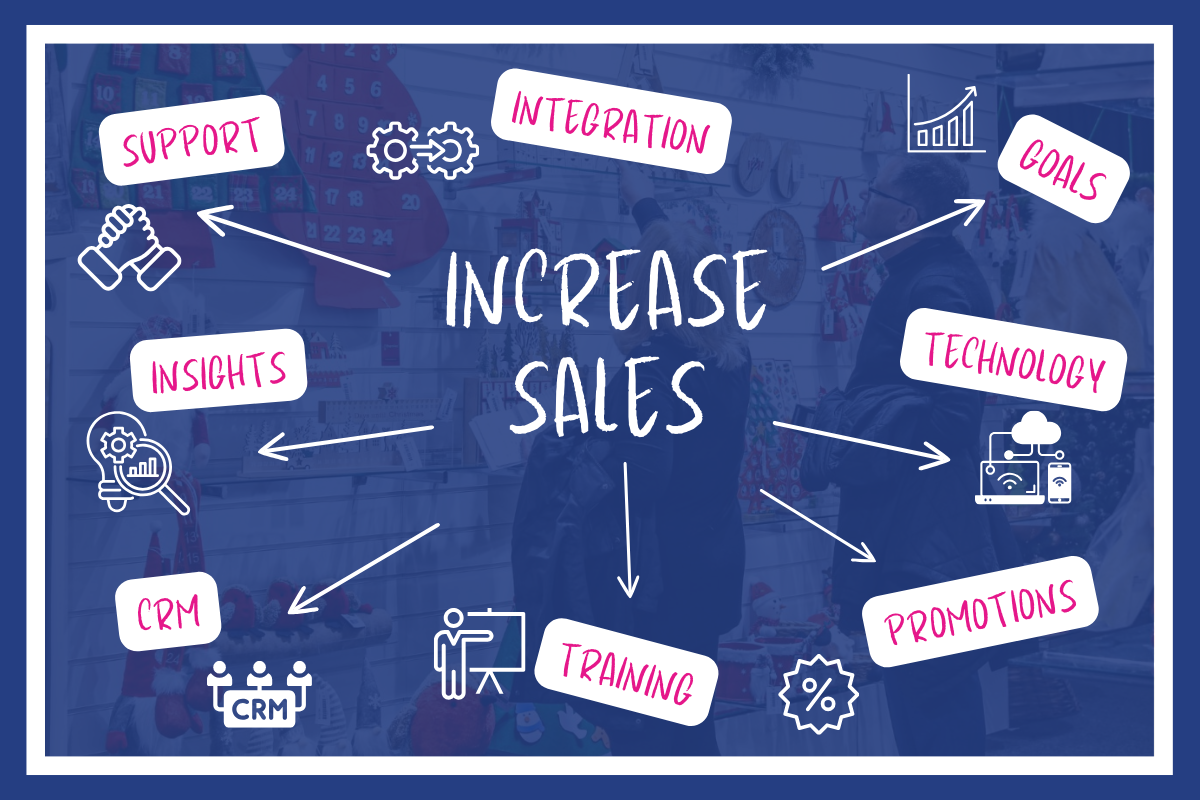How to improve sales rep performance

Learning how to improve sales rep performance is crucial for driving a company’s growth and maintaining competitive advantage.
In this blog, we’ll delve into effective methods to improve sales rep performance. From harnessing smart technologies to streamline sales processes, to fostering a culture of continuous improvement and recognition. Here we’ll cover the key strategies that can lead your field sales team to sustained success.
Offers and promotions
An easy way to significantly enhance sales rep performance is through targeted customer offers and promotions. By implementing strategic incentives such as volume discounts, BOGOFs, Buy 10 X get Y free etc, you’ll be giving your reps the tools to encourage larger purchases.
Time sensitive offers create urgency, motivating customers to make quicker purchasing decisions and allowing reps to close deals faster. Use this mechanic to reduce stock of old products or speed up introduction to a new range. ‘Buy 10 X get Y free’ type of promotions can promote cross selling. Not only will this increase sales, but also add value to your customer relationships.
Use a sales app like PixSell that has the functionality to feed head office designed offers through to your reps to use on the road. This ensures all offers, discounts and promotions are aligned with your broader sales and marketing strategies and ensures profit margins are protected.
Exclusive promotions and offers can provide sales reps with unique selling points that can differentiate them from competitors and foster customer loyalty.

Technology and integration
Integrating technology can significantly boost the performance of your field sales reps. Start by equipping them with smartphones or tablets with apps like PixSell, giving them access to real-time stock levels, correct customer pricing, detailed product data and CRM (Customer Relationship Management) functionality. This enables them to update and retrieve customer information in real-time, right from the field.
Additionally, use mobile sales applications that allow reps to process orders on the go, access product information quickly, and even check inventory levels. This reduces downtime and increases their ability to close deals efficiently.
Apps that map customer locations and plan optimal routes can save time and reduce travel costs, allowing reps to visit more clients each day. Also, consider tools that automate routine tasks such as scheduling follow-ups or generating reports, freeing up reps to focus more on selling.
For training and communication, utilise video conferencing tools to conduct regular training sessions and team meetings, ensuring reps are well-informed and aligned with company goals, regardless of their location.
By leveraging these technologies, you streamline your sales processes, enhance productivity, and ultimately increase the performance of your field sales team.

Utilise CRM tools
It’s a good idea to have CRM systems (or, at least some CRM functionality) accessible on mobile devices for your sales reps. This will allow them to access customer data, update records, and manage leads and sales opportunities directly from the field. Equip them with apps that sync in real-time with your CRM to keep all information current and accessible to everyone who needs it.
Use the CRM to analyse data and generate insights about customer preferences and behavior. This can guide reps to personalise their sales pitches and focus on the most promising leads. CRM tools can also streamline scheduling and follow-ups, reminding reps of the best times to contact each customer, increasing efficiency and effectiveness.
Additionally, integrate the CRM with other tools like email marketing platforms and social media for a comprehensive view of customer interactions. This integration helps reps understand the customer’s journey better and tailor their approach accordingly.
Many product distributors will decide that a fully functioning CRM is more than they need for their business. If this is the case, look to source the CRM functionality your team need in other ways. Some order taking apps, such as PixSell, will provide all the CRM functionality most sales team would benefit from such as customer sales history, journey mapping, financial history, product sales history, site images and notes.

Market and customer insights
Using market and customer insights effectively can significantly enhance the performance of your field sales reps. Start by gathering data on customer preferences, buying habits, and feedback. This information can be collected through surveys, customer interactions, and sales history. Analyse this data to identify trends and patterns that can inform your sales strategies.
Equip your sales reps with this knowledge so they can tailor their pitches and interactions according to the specific needs and preferences of each customer. For instance, understanding which products are popular in a particular region can help reps focus on promoting those items.
The more advanced order taking apps, such as PixSell, will contain all this data and allow for additional insights recording. If your sales app is a more basic version, you’ll need to find other ways to record and access this data.
Additionally, keep an eye on broader market trends that could impact customer behavior, such as economic shifts or new industry regulations. Sharing these insights with your team helps them anticipate customer concerns and address them proactively.
Finally, use customer feedback to continually refine your sales approach. Encouraging reps to adapt based on what works well or areas where customers express dissatisfaction can lead to improved sales tactics and better customer relationships. This cycle of gathering insights, implementing strategies based on these insights, and then adjusting as needed keeps your sales team agile and responsive to market and customer demands.

Training and development
Identify the specific skills and knowledge your team needs to succeed and work to ensure everyone is trained in those areas. Training could include product knowledge, sales tactics or customer service skills. Use this information to create focused training modules that are directly relevant to their daily tasks.
Incorporate a mix of learning methods such as online courses, in-person workshops, and hands-on practice. This variety helps cater to different learning styles and keeps the training engaging. For example, online courses can provide theoretical knowledge, while role-playing in workshops can offer practical experience in handling customer interactions.
Regular feedback is crucial. After training sessions, gather feedback from your team about what they found useful or areas they feel need more coverage. This will help tailor future training to be even more effective.
Also consider using technology to support continuous learning. Mobile learning apps can deliver bite-sized learning content that sales reps can access directly from the field, allowing them to learn on-the-go and apply new knowledge immediately. An added bonus would be if your sales app provider offers their own online training videos to ensure optimum use of the software.
Finally, set clear goals and track progress. This not only motivates your team but also helps you measure the effectiveness of your training programmes. Adjust the training as needed based on the outcomes you observe.

Sales team incentives
To boost the performance of your field sales reps using incentive programmes, focus on creating rewards that are both motivating and aligned with your business goals. Start by setting clear, achievable targets for sales performance, such as the number of new clients acquired or the volume of sales achieved. Make sure these targets are challenging yet attainable, to keep your team engaged without feeling overwhelmed.
Once the goals are set, design incentive programmes that reward the behaviors and results you want to encourage. This could include bonuses, commissions, or non-monetary rewards like extra annual leave or public recognition. The key is to make the rewards desirable enough to drive your team’s efforts.
Implement these incentives as part of a broader strategy that includes regular feedback and support. Encourage an environment where sales reps not only strive to meet targets for rewards but also receive constructive feedback to help them grow professionally. This approach ensures your incentive programme not only boosts immediate sales performance but also contributes to long-term skill development and job satisfaction for your sales team.

Offer support and resources
Providing strong sales support and resources is always key. Start by equipping your team with the latest technology and tools that streamline their sales processes. This might include mobile apps for order taking, CRM systems to manage customer interactions, or digital catalogues that showcase your products effectively.
Training is also crucial. Regular training sessions can help your reps stay updated on product changes, market trends, and effective sales strategies. This keeps them competent and confident when dealing with clients. If your team use PixSell for their order taking app, Aspin will ensure your team remain fully trained in order for you to achieve success.
Additionally, provide your team with easy access to marketing materials, such as brochures, product sheets, and case studies. With SkooCloud your head office team can build PDF catalogues templates for reps to personalise for their customers. These resources can help reps communicate the value of your products more clearly and effectively.
Lastly, ensure your reps have direct access to technical support or expert assistance when needed. This is especially important for complex products or services, where reps might need additional support to address customer questions or concerns accurately.
By investing in these support mechanisms, you help your sales reps become more efficient and effective, leading to better sales performance and higher customer satisfaction.

Use clear goals and metrics
To increase the performance of your field sales reps, setting clear goals and using specific metrics is essential. Begin by defining what success looks like for your team. This might be increasing sales by a certain percentage, acquiring a set number of new clients, or boosting repeat customer sales. Communicate these goals clearly and ensure every team member understands their individual and collective targets.
Next, choose metrics that accurately reflect progress towards these goals. Common sales metrics include sales volume, the number of new accounts, and customer retention rates. Track these metrics regularly, and share the results with your team. This not only keeps everyone informed but also fosters a sense of accountability.
Regularly review these goals and metrics with your sales reps to discuss their progress and any challenges they face. This ongoing dialogue helps you adjust strategies as needed and provides your team with the support they need to succeed. By consistently monitoring performance and providing clear, achievable goals, you can motivate your sales reps and drive better results.

Related Articles




